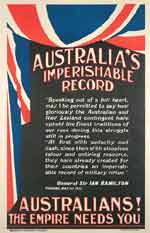 |
| Home | Working Man's Paradise? | Socialist Orator | From Revolutionary To Federal Politician | National Leader | ||
|
THE FEDERAL
GOVERNMENT IN 1916 In 1901, the new Commonwealth had powers over defence, customs, currency and federal territories. It shared power with the States over the postal and telegraph systems. In 1913 the Commonwealth introduced workers' compensation. But there was no such thing as responsibility for social welfare until the late 1940s. The coming of war allowed the Commonwealth to argue for greater powers. The Federal Government established a Federal Police Force, took over the management of lighthouses, and took complete control over the press and the national economy for the duration of the war. They were also involved in major |
public building projects such as a national railway line. The end of the war saw the development of the Repatriation Department (now known as Veteran's Affairs), provision of housing for returned soldiers and the establishment of a Foreign Affairs Department. "Australia's Imperishable Record, Australians! The Empire needs you." 1915, Australian government poster. By permission of the National Library of Australia. |
Opening of TransAustralian
Railway souvenir, 1917.
|

